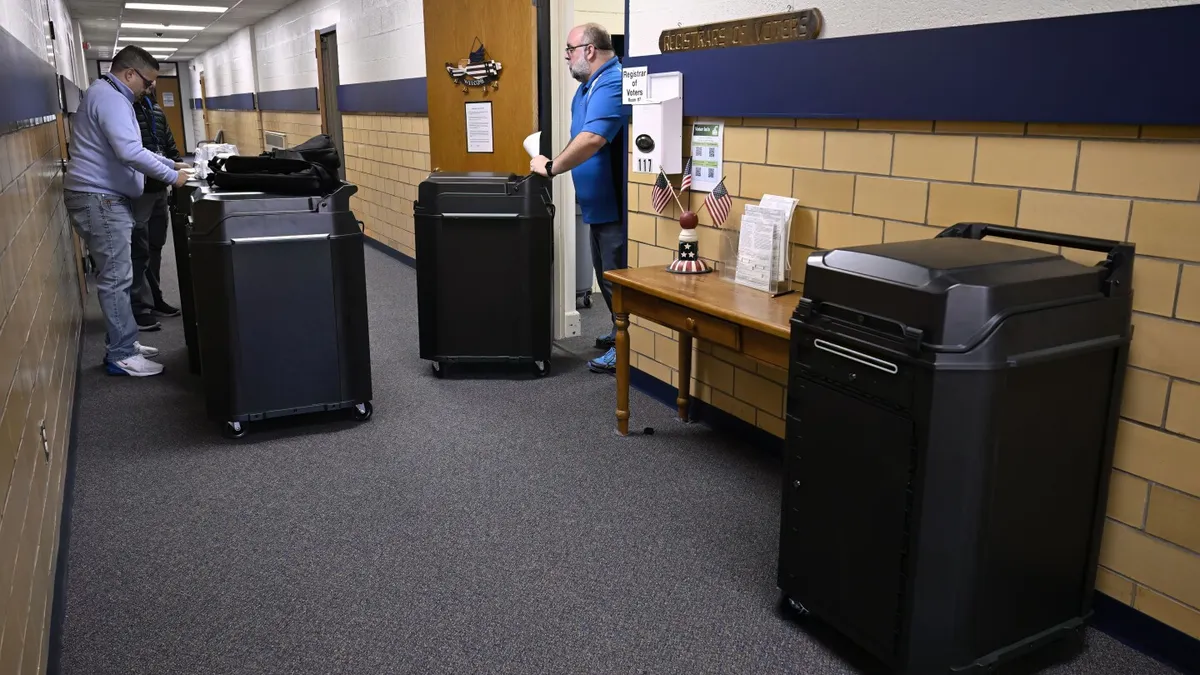
ATLANTA (AP) — President Donald Trump’s recent executive order aimed at altering the way U.S. elections are conducted is generating significant uncertainty among state and local election officials. This development raises concerns about potential voter confusion ahead of the upcoming federal elections, particularly the pivotal 2026 midterms. Election officials are already grappling with the loss of federal cybersecurity assistance, and this new executive order introduces the possibility of major changes, including a new voter registration requirement, decertification of certain voting systems, and stricter ballot deadlines for numerous states.
In Connecticut, Secretary of State Stephanie Thomas expressed optimism about the newly purchased $20 million ballot scanners being compliant with the executive order. However, she remains apprehensive about the impact on other states. “It’s not like states have millions and millions of dollars that they can just upgrade their election equipment every couple of years,” said Thomas, a Democrat. “Imagine people purchased new equipment and now it no longer can be used. There is no remedy for that in the order.” This lack of clarity surrounding the executive order increases uncertainty for election officials nationwide.
Joseph Kirk, who oversees elections in Bartow County, Georgia, voiced his concerns, stating, “I have no idea what the timeline is for things in the executive order. I really hope we have some clarity on some of this stuff soon because no matter what the answers are, I need to take care of my voters.”
In the executive order, Trump criticized the performance of election officials across the nation while praising how elections are conducted in other countries. He has long questioned the integrity of U.S. elections, perpetuating false claims about widespread voter fraud following his 2016 win and his 2020 loss to Joe Biden. Despite extensive reviews confirming no evidence of widespread fraud or manipulation, Trump's assertions have influenced public perception.
Election officials have faced increased harassment and threats, compounded by legislative changes aimed at restoring public confidence in the electoral process. Concerns have arisen about the federal government's role in elections, particularly with the Trump administration's recent decisions to pause certain cybersecurity initiatives and withdraw funding for an information-sharing network for election offices. Larry Norden, an election security expert with the Brennan Center for Justice, noted, “States run our elections, but the federal government has been an important partner in assisting election officials. To be a partner, you have to be trusted. The last few months have utterly destroyed that.”
One of the most contentious changes outlined in the executive order is the requirement for individuals to provide documentary proof of U.S. citizenship when registering to vote. This initiative, which was previously pushed by Republicans in Congress, stalled amid Democratic opposition. However, House Republicans are set to revisit this issue with the proposed Safeguard American Voter Eligibility Act, or the SAVE Act.
Several Republican state election officials have expressed support for the provisions directing federal agencies to assist states in verifying voter eligibility and citizenship. In contrast, their Democratic counterparts have raised concerns about the feasibility of the citizenship requirement, noting that millions of Americans lack easy access to birth certificates, and many married women would need multiple documents due to name changes. Voting rights advocates argue that while noncitizen voting occurs, it is often unintentional and represents a minuscule fraction of total ballots.
Under Trump’s order, the responsibility for implementing this requirement would fall to election officials, leading to increased costs without any additional federal funding for support. David Becker, a former Justice Department lawyer, emphasized the potential bureaucratic burden, stating, “You don’t wave a magic wand and do that.”
Kate Sweeney Bell, who oversees elections in Marion County, Indiana, does not foresee major issues in her state due to its already restrictive voting laws. However, she is concerned about the public education necessary for other states to adapt to potential changes. “It’s a rough couple of election cycles when changes like this are made,” Sweeney Bell remarked.
Protracted legal challenges resulting from the executive order could delay clarity for both election officials and voters. Ryan Macias, an expert in election security and voting systems, warned, “If election officials are uncertain about the rules, there is no doubt that voters will not understand them — creating distrust in the process and ultimately in the validity of the outcome.”
Trump’s executive order also seeks to amend standards for voting systems, potentially requiring counties to replace their voting machines without providing additional funding. The order mandates that the U.S. Election Assistance Commission review and amend voluntary standards for voting systems within 180 days, which could necessitate the decertification of previously approved equipment.
Experts point out that while there are voting systems that do not use barcodes, the process to replace equipment is lengthy and involves multiple steps, including procurement and training. Mark Lindeman, policy and strategy director with Verified Voting, highlighted the challenges states face in rapidly procuring and implementing new systems: “It’s hard for any state to procure and obtain and test new voting systems, and if there was some mad rush for many states to replace their voting systems at once, we don’t know how many systems manufacturers could supply.”
As election officials prepare for the 2026 elections, the implications of Trump’s executive order remain uncertain, marked by concerns over voter confusion and operational challenges that could undermine confidence in the electoral process.